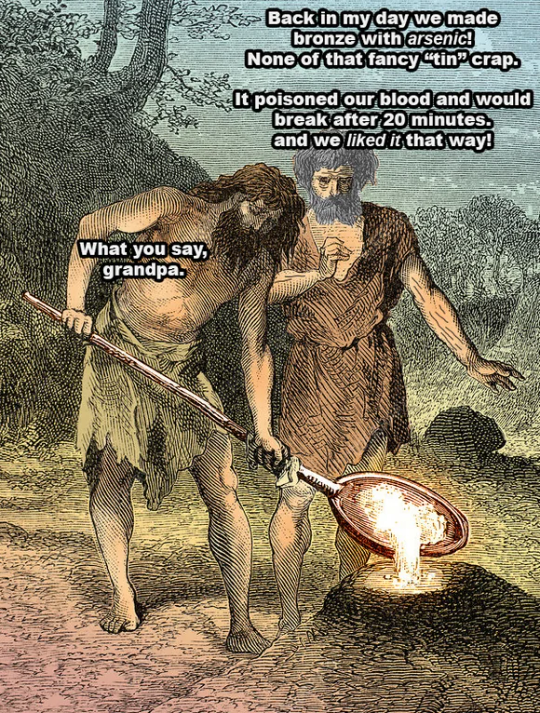#Technically arsenic bronze would bend afaik but the meme was too funny not to include.
Explore tagged Tumblr posts
Note
How competitive was the copper market? Would Ea-Nasir have been one of many sellers of broadly equivalent status all trying to make a buck, like how one town might have six building firms all competing for work, or would he have had a near-monopoly like Starbucks? Would he have been a sole trader who brokered deals between mines and consumers, or would he have managed a warehouse with employees and held stock, etc?
Oh SHIT, I never answered this and it got lost in my drafts! I'm so sorry.
This is a fantastic question! Just to flesh out the picture of the trade in the day: Bronze is an alloy of copper (Cu) with either arsenic (As) or tin (Sn). Arsenic is a common unwanted element in copper deposits, and copper-arsenic-oxide (Cu-As-O) minerals look very similar to plain copper minerals. However, tin (Sn) occurs in very different, rarer, geologic environments, and thus must be sourced from different areas.
Likewise, As-Bronze is less malleable than copper, but not by much; arsenic ions are about the same size. Tin ions form good bronze because they're larger than the copper ions and prevent the metal from freely deforming, so it was prioritized for weapons and tools. Arsenic was used when tin wasn't available.

Ur was known for being one of the best cities for bronzework during the Bronze Age: metalworking services were in high demand, and they were the center of the copper, arsenic, and tin trades. Copper from Oman (or Cyprus, as their industry was developing more at the time), tin from Afghanistan, Southeast Asia, or Turkey, (depending on which archaeologist you talk to), and arsenic from India or Egypt.
So yeah, as a middleman, Ea-Nasir probably had numerous competitors who procured copper from Oman, particularly from the halfway point in Qatar, and then sent it back to Ur. Also referencing the plural translation "-those of the people who travel to Dilmun-", although likely only a few of those merchants were chosen to sell to the temple/government. (But that's speculation. Maybe the temple picked one person a year? Maybe copper tithes meant there was usually supply, and it was only this year during war the temple picked Ea-Nasir to buy from.)
It's also quite possible there were people doing copper business like Ea-Nasir further up the Tigris and Euphrates closer to Cyprus, and there were definitely specialist merchants for arsenic-copper and tin procurement. Once the copper was in the city, his buyers were refiners and metallurgists who made the bronze or copper wares that were purchased/exported throughout the Middle East.
As for employees and stock, I honestly don't know. But from the letters, it sounds like he was stretched rather thin, and he was dealing with buyers' messengers himself. So I wouldn't be surprised (although this is speculation) if it was just him and perhaps a servant/slave of the period to handle things in Ur while he was in Dilmun.
[Image References under the cut]
meme from r/historymemes
Peterson, 2012. Forging Social Networks: Metallurgy and the Politics of Value in Bronze Age Eurasia. The Archaeology of Power and Politics in Eurasia. Cambridge University Press. DOI: https://doi.org/10.1017/CBO9781139061186.018
Content References within my other Ea-Nasir writeups under iamthepulta: #mining history, or #ea nasir
#copper#metallurgy#mining history#trade#bronze age#ea nasir#Technically arsenic bronze would bend afaik but the meme was too funny not to include.
44 notes
·
View notes